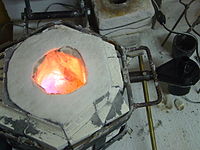Gas burner
Appearance




A gas burner is a device to generate a flame to heat up products using a gaseous fuel such as acetylene, natural gas or propane. Some burners have an air inlet to mix the fuel gas with air to make a complete combustion. Acetylene is commonly used in combination with oxygen.
It has many applications such as soldering, brazing and welding, the latter using oxygen instead of air for getting a hotter flame which is required for melting steel. For laboratory uses a natural gas fired Bunsen burner is used. For melting metals with melting points of up to 1100 °C such as copper, silver and gold a propane burner with natural drag of air can be used.
Table 1: Flame temperatures of common gases and fuels
| Gas / Fuels | Flame temperature |
|---|---|
| Propane in air | 1980 °C |
| Butane in air | 1970 °C |
| Wood in air (normally not reached in a wood stove) | 1980 °C |
| Acetylene in air | 2550 °C |
| Methane (natural gas) in air | 1950 °C |
| Hydrogen in air | 2111 °C |
| Propane with oxygen | 2800 °C |
| Acetylene in oxygen | 3100 °C + |
| Propane-butane mix with air | 1970 °C ~ |
| Coal in air | 1900 °C (blast furnace) |
| Cyanogen (C2N2) in oxygen | 4525 °C |
| Dicyanoacetylene (C4N2) in oxygen | 4982 °C (highest flame temperature) |
Info & Assuming:
- Adiabatic flame
- 20 degrees Celsius 1 bar atmosphere
- Complete combustion (no soot and more blue-like flame is the key) (Stoichiometric)
- Peak Temperature
- Speed of Combustion (has no effect on temp, but more energy released per second (as adiabatic) compared to normal flame)
- Spectral bands also affect colour of flame as of what part and elements of combustion
- Blackbody radiation (colour appearance only because of heat)
- Atmosphere - affects temperature of flame and colour due the atmospheric colour effect
Table 2: Explosive limits and ignition temperatures of common gases
| Explosive limits (lower & upper, in %) | Ignition temperatures | |
|---|---|---|
| Natural gas | 4.7 & 15 | 482-632 °C |
| Propane | 2.15 & 9.6 | 493-604 °C |
| Butane | 1.9 & 8.5 | 482-538 °C |
| Acetylene | 2.5 & 81 | 305 °C |
| Hydrogen | 4 & 75 | 500 °C |
| Ammonia | 16 & 25 | 651 °C |
| Carbon monoxide | 12.5 & 74 | 609 °C |
| Ethylene | 3.4 & 10.8 | 490 °C |
Note: Atmosphere is air at 20 degrees Celsius.
Table 3: Combustion values of common gases
| Gas | Combustion value | |
|---|---|---|
| (Btu/ft³) | (MJ/m³) | |
| Natural gas (methane) | 950 to 1,150 | 35 to 43 |
| Propane-butane mix | 2,500 to 3,200 | 90 to 120 |
| Propane | 2,572 | 95.8 |
| Butane | 3,225 | 120.1 |
References
- Pocket Guide to fire and arson investigation, second edition, FM Global, Table 1,2 and 3
